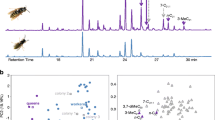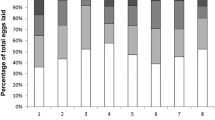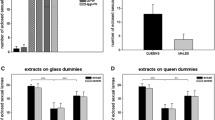Abstract
In ants dispersing through colony fission, queens mate near their natal nest and found a new society with the help of workers. This allows potential future queens to challenge the mother queen’s reproductive monopoly. Conflicts might be resolved if the mated queen signals her presence and the workers control the developmental fate of the diploid larvae (whether they develop to worker or queen). In this study we sought to determine whether, in the fission-performing ant Aphaenogaster senilis, conflicts between queens for control of the colony are resolved by the resident queen signalling her mating status. Virgin queens were less effective than newly mated queens in inhibiting queen rearing. Moreover, potential challenger queens were recognized and heavily aggressed independent of mating status. Chemical analyses showed that mating status was associated with changes in cuticular hydrocarbon and poison gland composition, but not in Dufour’s gland composition. Cuticular dimethylalkanes were identified as potential constituents that signal both caste (present in queens only) and mating status (mated queens have higher amounts). We hypothesised that pheromone emission by virgin queens did not reach the threshold needed to fully inhibit larval development into queens but was sufficiently high to stimulate overt aggression by mated queens. These findings provide evidence for the complexity of chemical communication in social insects, in which a small number of signals may have a variety of effects, depending on the context.




Similar content being viewed by others
References
Amor F, Ortega P, Jowers MJ, Cerdá X, Billen J, Lenoir A, Boulay RR (2011) The evolution of worker-queen polymorphism in Cataglyphis ants: interplay between individual- and colony-level selections. Behav Ecol Sociobiol 65:1473–1482
Bhadra A, Iyer PL, Sumana A, Deshpande SA, Ghosh S, Gadagkar R (2007) How do workers of the primitively eusocial wasp Ropalidia marginata detect the presence of their queens? J Theor Biol 246:574–582
Boulay R, Hefetz A, Cerdá X, Devers S, Francke W, Twele R, Lenoir A (2007) Production of sexuals in a fission-performing ant: dual effects of queen pheromones and colony size. Behav Ecol Sociobiol 61:1531–1541
Boulay R, Cerdá X, Fertin A, Ichinose K, Lenoir A (2009) Brood development into sexual females depends on the presence of a queen but on temperature in an ant deispersing by colony fission, Aphaenogaster senilis. Ecol Entomol 34:595–602
Boulay R, Galarza JA, Chéron B, Hefetz A, Lenoir A, Van Oudenhove L, Cerdá X (2010) Intraspecific competition affects population size and resource allocation in an ant dispersing by colony fission. Ecology 91:3312–3321
Bourke AFG, Franks NR (1995) Social Evolution in Ants. Princeton University Press, Princeton
Bourke AFG, Ratnieks FLW (1999) Kin conflict over caste determination in social Hymenoptera. Behav Ecol Sociobiol 46:287–297
Buschinger A (2003) Mating behavior in the ant, Myrmecina graminicola (Myrmicinae). Insectes Soc 50:295–296
Castella G, Christe P, Chapuisat M (2009) Mating triggers dynamic immune regulations in wood ant queens. J Evol Biol 22:564–570
Chéron B, Cronin AL, Doums C, Fédérici P, Haussy C, Tirard C, Monnin T (2011) Unequal resource allocation among colonies produced by fission in the ant Cataglyphis cursor. Ecology 92:1448–1458
Cronin AL, Molet M, Doums C, Monnin T, Peeters C (2013) Recurrent evolution of dependent colony foundation across eusocial insects. Ann Rev Entomol 58:37–65
Crozier RH, Pamilo P (1996) Evolution of social insect colonies. Sex allocation and kin-selection. Oxford University Press, Oxford
D’Ettorre P, Heinze E, Schulz C, Francke W, Ayasse M (2004) Does she smell like a queen? Chemoreception of a cuticular hydrocarbon signal in the ant Pachycondyla inversa. J Exp Biol 207:1085–1091
Galarza JA, Jovani R, Cerdá X, Rico C, Barroso Á, Boulay R (2012) Frequent colony relocations do not result in effective dispersal in the gypsy ant Aphaenogaster senilis. Oikos 121:605–613
Gotwald WH (1995) Army ants: the biology of social predation. Cornell University Press, Ithaca
Hamilton WD (1964) The genetical evolution of social behaviour I. J Theor Biol 7:1–16
Hannonen M, Sledge MF, Turillazzi S, Sundström L (2002) Queen reproduction, chemical signalling and worker behaviour in polygyne colonies of the ant Formica fusca. Anim Behav 64:477–485
Hefetz A (2007) The evolution of hydrocarbon pheromone parsimony in ants (Hymenoptera: Formicidae) – interplay of colony odor uniformity and odor idiosyncrasy. A review. Myrmecol News 10:59–66
Hölldobler B, Carlin NF (1989) Colony founding, queen control and worker reproduction in the ant Aphaenogaster (=Novomessor) cockerelli (Hymenoptera: Formicidae). Psyche 96:131–151
Hölldobler B, Wilson EO (2009) The Superorganism: The Beauty, Elegance, and Strangeness of Insect Societies Norton & Co. Incorporated, New York
Holman L, Jørgensen CG, Nielsen J, D’Ettorre P (2010) Identification of an ant queen pheromone regulating worker sterility. Proc R Soc Lond 277:3793–3800
Hora RR, Ionescu-Hirsh A, Simon T, Delabie J, Robert J, Fresneau D, Hefetz A (2008) Postmating changes in cuticular chemistry and visual appearance in Ectatomma tuberculatum queens (Formicidae: Ectatomminae). Naturwissenschaften 95:55–60
Ichinose K, Cerdá X, Christidès J-P, Lenoir A (2005) Detecting nestmate recognition patterns in the fission-performing ant Aphaenogaster senilis: a comparison of Different Indices. J Insect Behav 18:633–650
Iwanishi S, Hasegawa E, Ohkawara K (2003) Worker oviposition and policing behaviour in the myrmicine ant Aphaenogaster smythiesi japonica. Forel Anim Behav 66:513–519
Johnson CA, Sundström L (2012) Cuticular chemistry of two social forms in a facultatively polygyne ant (Hymenoptera: Formicidae: Formica truncorum). Ann Zool Fennici 49:1–17
Keller L (1991) Queen number, mode of colony founding, and queen reproductive success in ants (Hymenoptera, Formicidae). Ethol Ecol Evol 3:307–316
Klobuchar EA, Deslippe RJ (2002) A queen pheromone induces workers to kill sexual larvae in colonies of the red imported fire ant (Solenopsis invicta). Naturwissenschaften 89:302–304
Kocher SD, Richard FJ, Tarpy DR, Grozinger CM (2008) Genomic analysis of post-mating changes in the honey bee queen (Apis mellifera). BMC Genomics 9:232
Kocher SD, Richard FJ, Tarpy DR, Grozinger CM (2009) Queen reproductive state modulates pheromone production and queen-worker interactions in honeybees. Behav Ecol 20:1007–1014
Liautard C, Keller L (2001) Restricted effective queen dispersal at a microgeographic scale in polygynous populations of the ant Formica exsecta. Evolution 55:2484–2492
Liang D, Silverman J (2000) “You are what you eat”: Diet modifies cuticular hydrocarbons and nestmate recognition in the Argentine ant. Linepithema humile Naturwissenschaften 87:412–416
Leniaud L, Darras H, Boulay R, Aron S (2012) Social hybridogenesis in the clonal ant Cataglyphis hispanica. Cur Biol 22:1188–1193
Liebig J, Peeters C, Oldham NJ, Markstadter C, Hölldobler B (2000) Are variations in cuticular hydrocarbons of queens and workers a reliable signal of fertility in the ant Harpegnathos saltator? Proc Natl Acad Sci USA 97:4124–4131
Monnin T, Peeters C (1997) Cannibalism of subordinates’ eggs in the monogynous queenless ant Dinoponera quadriceps. Naturwissenschaften 84:499–502
Monnin T, Ratnieks FLW, Jones GR, Beard R (2002) Pretender punishment induced by chemical signalling in a queenless ant. Nature 419:61–65
Nonacs P, Tobin JE (1992) Selfish larvae: Development and the evolution of parasitic behavior in the Hymenoptera. Soc Study Evol 46:1605–1620
Pamilo P (1991) Evolution of colony characteristics in social insects II. Number of reproductive individuals. Am Nat 138:412–433
Pearcy M, Aron S, Doums C, Keller L (2004) Conditional use of sex and parthenogenesis for worker and queen production in ants. Science 306:1780–1783
Quinn G, Keough M (2002) Experimental design and data analysis Cambridge University Press, Cambridge
Ross K, Matthews G (1991) The social biology of wasps. Comstock Publishing Associates, Ithaca and London
Ruel C, Cerdá X, Boulay R (2012) Behaviour-mediated group size effect constrains reproductive decision in a social insect. Anim Behav 84:853–860
Ruel C, Lenoir A, Cerdá X, Boulay R (2013) Surface lipids of queen-laid eggs do not regulate queen production in a fission-performing ant. Naturwissenschaften 100:91–100
Seeley TD (1985) Honeybee ecology: a study of adaptation in social life. Princeton University Press, Princeton
Smith AA, Hölldober B, Liebig J (2009) Cuticular hydrocarbons reliably identify cheaters and allow enforcement of altruism in a social insect. Curr Biol 19:78–81
Smith AA, Hölldobler B, Liebig J (2012) Queen-specific signals and worker punishment in the ant Aphaenogaster cockerelli: the role of the Dufour’s gland. Anim Behav 83:587–593
Vander Meer RK, Morel L (1995) Ant queens deposit pheromones and antimicrobial agents on eggs. Naturwissenschaften 82: 93–95
Vander Meer RK, Glancey BM, Lofgren CS, Glover A, Tumlinson JH, Rocca J (1980) The poison sac of red imported fire ant queens - source of a pheromone attractant (Hymenopetra, Formicidae). Ann Entomol Soc Am 73:609–612
Vander Meer RK, Breed MD, Espelie KE, Winston ML (1998) Pheromone communication in social insects: ants, wasps, bees, and termites. Westview Press, Boulder, CO
Vargo EL (1997) Poison gland of queen fire ants (Solenopsis invicta) is the source of a primer pheromone. Naturwissenschaften 84:507–510
Vargo EL, Husley CD (2000) Multiple glandular origins of queen pheromones in the fire ant Solenopsis invicta. J Insect Physiol 46:1151–1159
Wenseleers T, Ratnieks FLW (2004) Tragedy of the commons in Melipona bees. Proc R Soc of Lond B 271:S310–S312
Acknowledgments
We are grateful to Ana Carvajal for laboratory assistance, and Jessica Pearce, Louise van Oudenhove, Christophe Lejeusne, Michael Jowers and Fernando Amor for their help in the field. We also thank the authority of the Doñana National Park for approving this research. We thank Naomi Paz for editing the English and Liselotte Sundström, Alain Lenoir and Jelle van Zweden for important comments on this manuscript. This work was funded by MICINN and FEDER (projects CGL2009-12472 to RB and CGL2009-09690 to XC). All experiments comply with the current Spanish legislation.
Author information
Authors and Affiliations
Corresponding author
Additional information
Communicated by L. Sundström
Electronic supplementary material
Below is the link to the electronic supplementary material.
ESM 1
(DOCX 3859 kb)
Rights and permissions
About this article
Cite this article
Ruel, C., Hefetz, A., Cerdá, X. et al. Recognition of caste and mating status maintains monogyny in the ant Aphaenogaster senilis . Behav Ecol Sociobiol 67, 1295–1305 (2013). https://doi.org/10.1007/s00265-013-1558-x
Received:
Revised:
Accepted:
Published:
Issue Date:
DOI: https://doi.org/10.1007/s00265-013-1558-x




